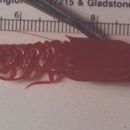Look Alikes
provided by Invertebrates of the Salish Sea
How to Distinguish from Similar Species: N. ingens has a relatively shorter rostrum with smaller serrations. Its antennal scale is ovate with small spines. Its supraorbital spine is small or may be absent. Both the anterior and the posterior lobes of the pleuralplates of abdominal segments 2-5 are pointed. Unlike Gnathophausia gracilis, this species does not have prominent dorsal spines on the abdominal segments.
- license
- cc-by-nc-sa
- copyright
- Rosario Beach Marine Laboratory
Habitat
provided by Invertebrates of the Salish Sea
Bathypelagic. Seems to live in waters of approximately 4 degrees C
- license
- cc-by-nc-sa
- copyright
- Rosario Beach Marine Laboratory
Habitat
provided by Invertebrates of the Salish Sea
Depth Range: 600-4400 m
- license
- cc-by-nc-sa
- copyright
- Rosario Beach Marine Laboratory
Comprehensive Description
provided by Invertebrates of the Salish Sea
This bright red lophogastrid mysid has a long rostrum lined with spines. It does not have dorsal spines on the abdomen. The antennal scale is whole, lanceolate, without a distinctly isolated distal part separated from the proximal part by an articulation. The external margin of the antennal scale is serrated, with 3-9 large spines. Supraorbital spine is well developed. Dactyls of thoracopods 3-8 elongated, lanceolate, with 8-10 spines along nearly the entire length of the inner margin. The pleural plates of abdominal segments 2-5 have a rounded anterior lobe and spiniform posterior lobe. The epimeral plates of the sixth abdominal segment are knitted together ventrally to form an indivisible plate with a deep cleft at the distal end. Maximum length to 16.4 cm. Probably attain maturity at about 12 cm.
- license
- cc-by-nc-sa
- copyright
- Rosario Beach Marine Laboratory
Comprehensive Description
provided by Invertebrates of the Salish Sea
Biology/Natural History: Reach sexual maturity at about 12 cm total length. Spination and relative length of rostrum is greater in smaller individuals, which originally led to small individuals being called the separate species G. drepanephora. This species is less common than is N. ingens off our coast Lophogastrids were formerly thought to be a type of mysid. This species lives permanently below the euphotic zone. Neognathophausia gigas swims constantly, primarily with the pleopods, with some participation by the thoracic exopods. Gnathophausia means "light-jaw". This species has a gland on its second maxillae from which it spews a brilliantly luminescent cloud into the water when disturbed. Luminescence seems to be a function of diet, since animals of a related species, Neognathophausia ingens, maintained on non-luminescent food in the laboratory gradually lose their ability to luminesce, while if luminescent food is restored they can regain their luminescence. Neognathophausia gigas is sometimes parasitized by an ellobiopsid flagellate protozoan, Amallocystis fascitus, which forms a cluster of white filaments on the ventral side of the anterior abdominal segment. The parasite seems to be associated with the main nerve ganglion in this segment, and is associated with hypertrophy of the ganglion. In N. ingens it also retards sexual maturation such as retarded development of oostegites in females and feminizing changes in males.
- license
- cc-by-nc-sa
- copyright
- Rosario Beach Marine Laboratory
Distribution
provided by Invertebrates of the Salish Sea
Geographical Range: Cosmopolitan in tropical and temperate waters; from S Alaska south in our waters.
- license
- cc-by-nc-sa
- copyright
- Rosario Beach Marine Laboratory

